TOYOTA YARIS 2017 3.G Owners Manual
Manufacturer: TOYOTA, Model Year: 2017, Model line: YARIS, Model: TOYOTA YARIS 2017 3.GPages: 396, PDF Size: 7.08 MB
Page 171 of 396

1714-5. Toyota Safety Sense C
4
Driving
• When driving on a narrow path surrounded by a structure, such as in atunnel or on an iron bridge
• When using an automatic car wash • When there is a vehicle or object by the roadside at the entrance of a
curve
• When there is a reflective object (manhole cover, steel plate, etc.),
steps, dip, or a protrusion on the road
surface or roadside
• When passing through a place with a low structure above the road (low ceil-
ing, traffic sign, etc.)
• When there is a structural object (overpass, traffic sign, billboard,
street light, etc.) at the top of an uphill
road
• When rapidly closing on an electric toll gate barrier, parking area barrier,
or other barrier that opens and closes
Page 172 of 396
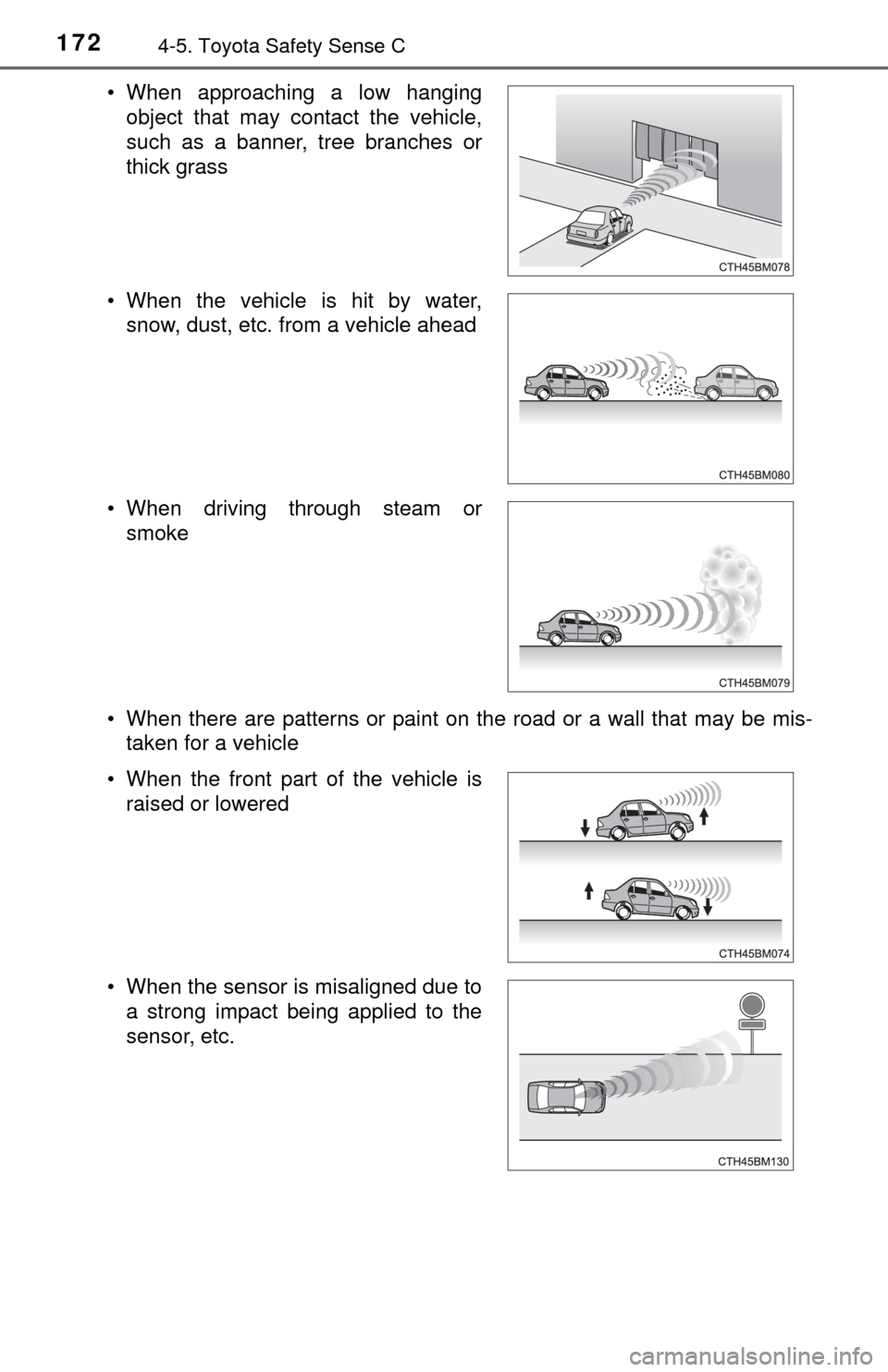
1724-5. Toyota Safety Sense C
• When there are patterns or paint on the road or a wall that may be mis-taken for a vehicle
• When approaching a low hanging
object that may contact the vehicle,
such as a banner, tree branches or
thick grass
• When the vehicle is hit by water, snow, dust, etc. from a vehicle ahead
• When driving through steam or smoke
• When the front part of the vehicle is raised or lowered
• When the sensor is misaligned due to a strong impact being applied to the
sensor, etc.
Page 173 of 396
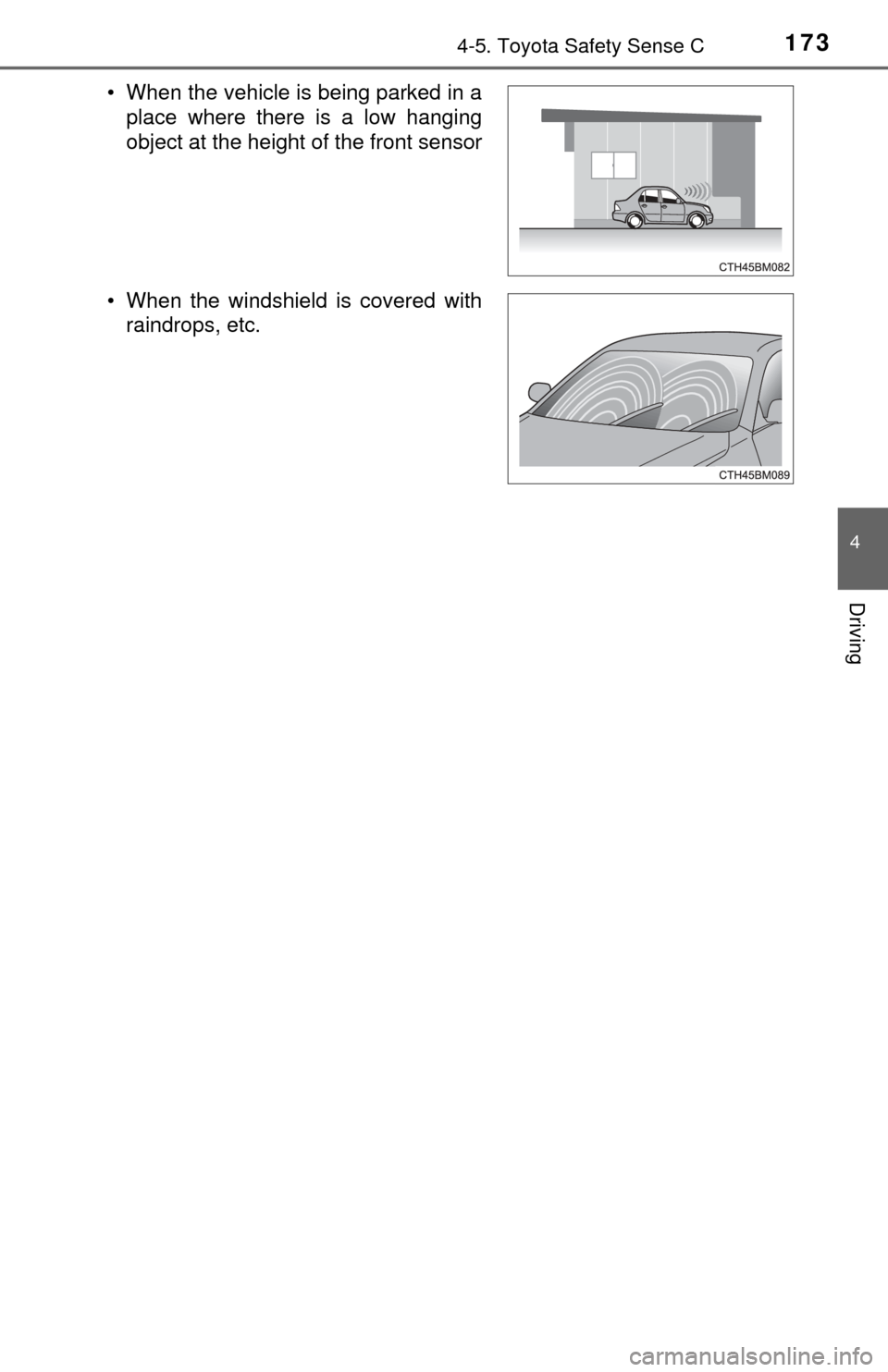
1734-5. Toyota Safety Sense C
4
Driving
• When the vehicle is being parked in aplace where there is a low hanging
object at the height of the front sensor
• When the windshield is covered with raindrops, etc.
Page 174 of 396
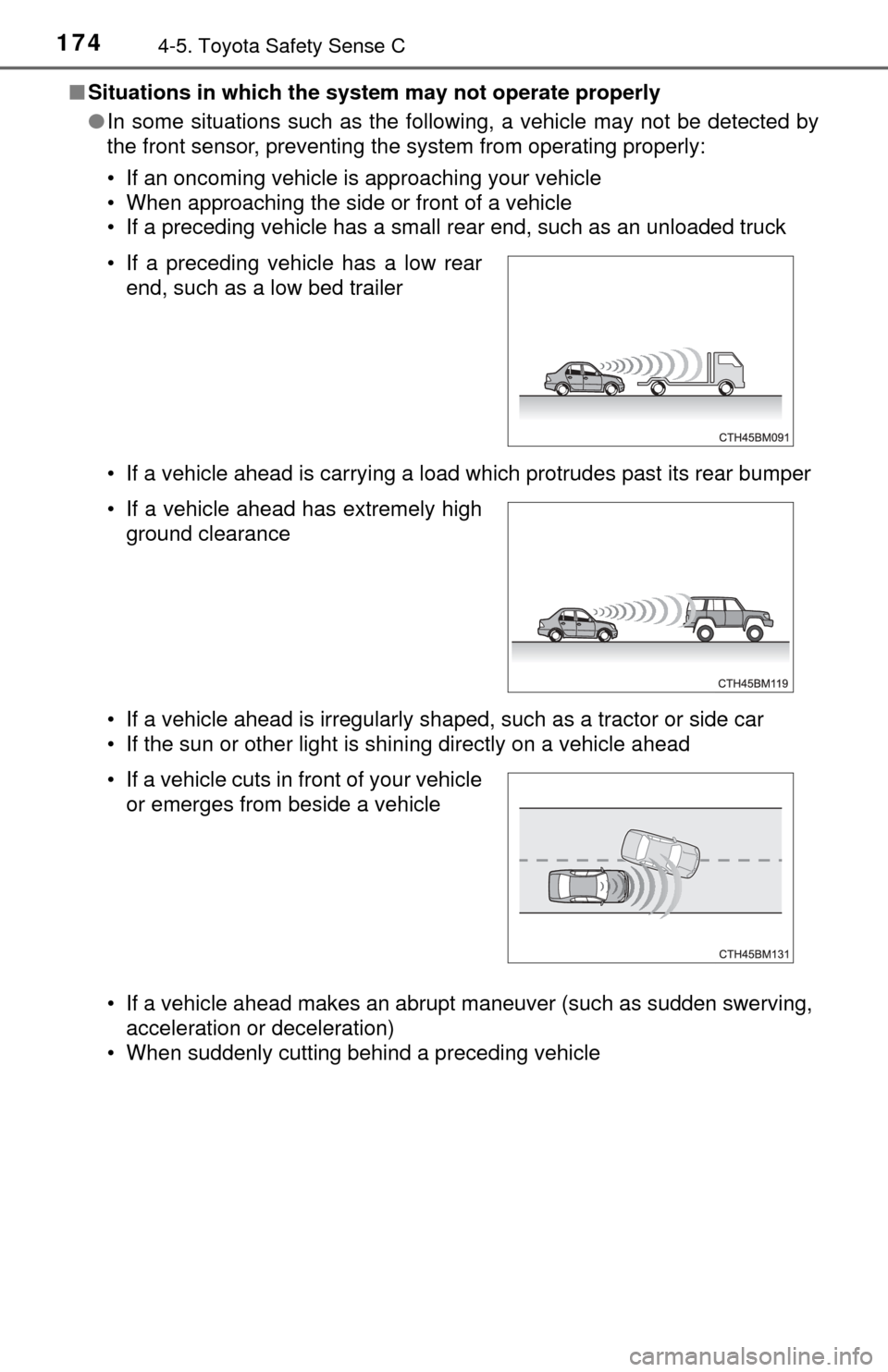
1744-5. Toyota Safety Sense C
■Situations in which the system may not operate properly
●In some situations such as the following, a vehicle may not be detected by
the front sensor, preventing the system from operating properly:
• If an oncoming vehicle is approaching your vehicle
• When approaching the side or front of a vehicle
• If a preceding vehicle has a small rear end, such as an unloaded truck
• If a vehicle ahead is carrying a load which protrudes past its rear bumper
• If a vehicle ahead is irregularly shaped, such as a tractor or side car
• If the sun or other light is shining directly on a vehicle ahead
• If a vehicle ahead makes an abrupt maneuver (such as sudden swerving,
acceleration or deceleration)
• When suddenly cutting behind a preceding vehicle • If a preceding vehicle has a low rear end, such as a low bed trailer
• If a vehicle ahead has extremely high ground clearance
• If a vehicle cuts in front of your vehicle or emerges from beside a vehicle
Page 175 of 396
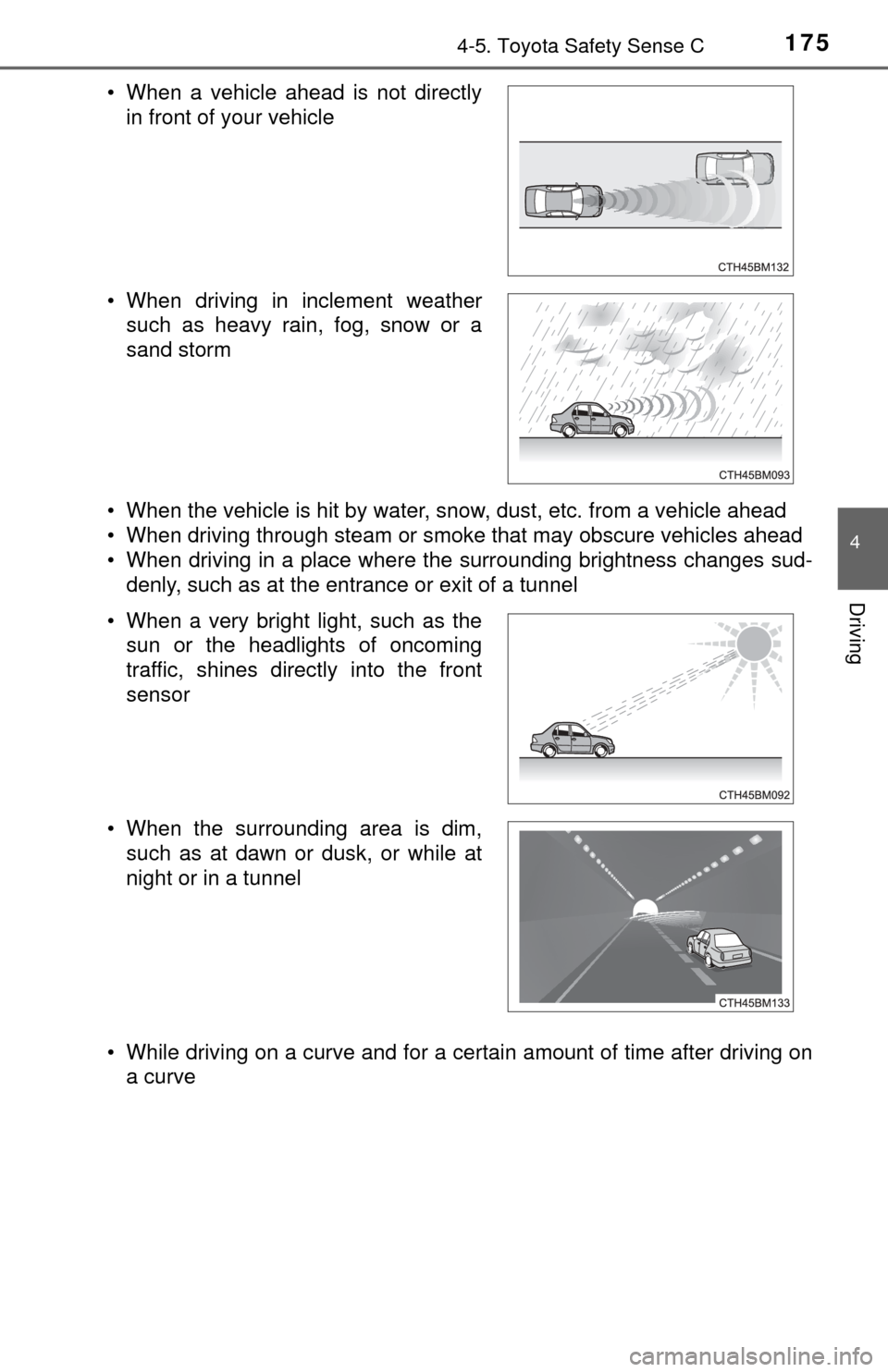
1754-5. Toyota Safety Sense C
4
Driving
• When the vehicle is hit by water, snow, dust, etc. from a vehicle ahead
• When driving through steam or smoke that may obscure vehicles ahead
• When driving in a place where the surrounding brightness changes sud-denly, such as at the entrance or exit of a tunnel
• While driving on a curve and for a certain amount of time after driving on a curve
• When a vehicle ahead is not directly
in front of your vehicle
• When driving in inclement weather such as heavy rain, fog, snow or a
sand storm
• When a very bright light, such as the sun or the headlights of oncoming
traffic, shines directly into the front
sensor
• When the surrounding area is dim, such as at dawn or dusk, or while at
night or in a tunnel
Page 176 of 396
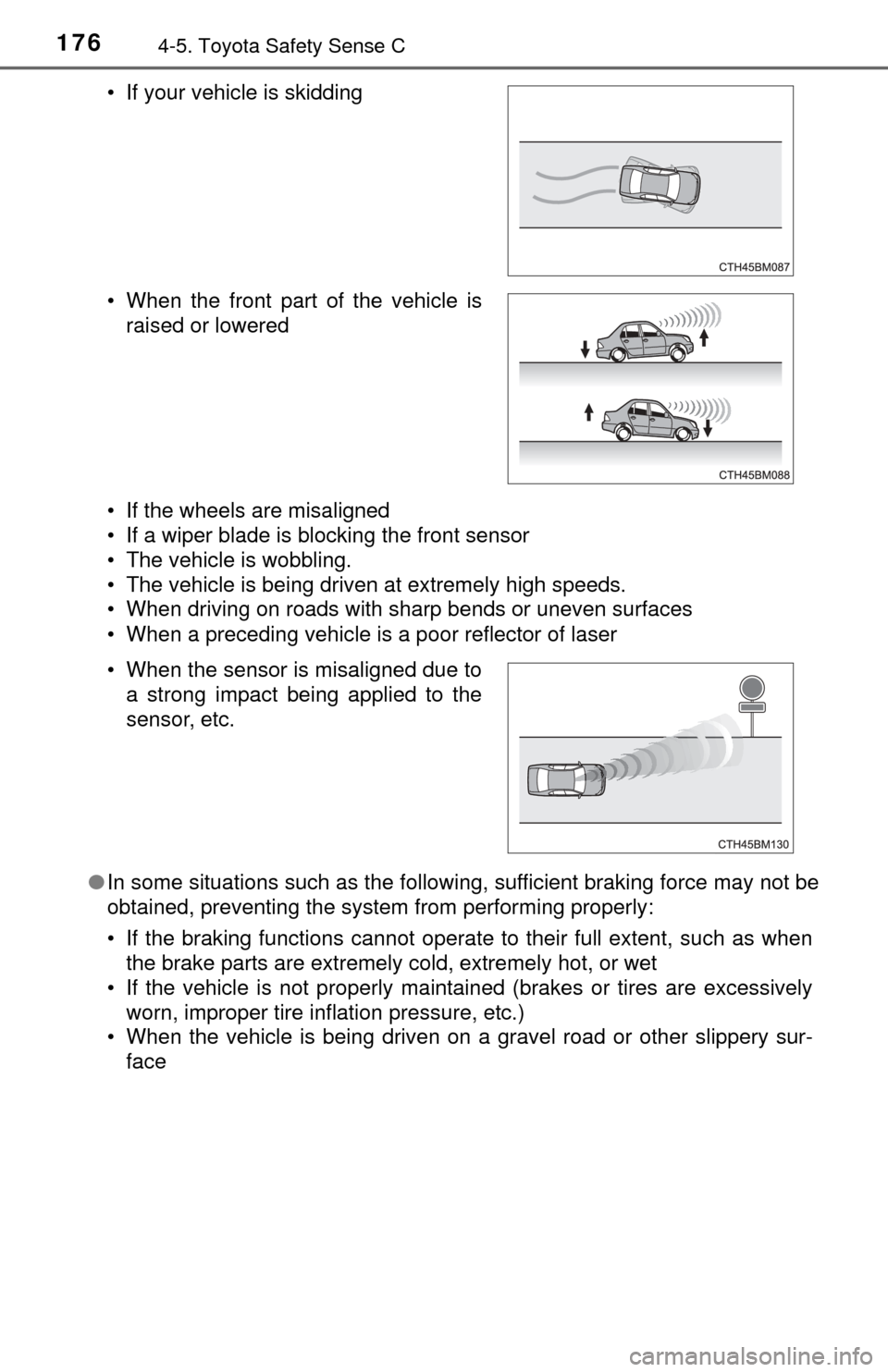
1764-5. Toyota Safety Sense C
• If the wheels are misaligned
• If a wiper blade is blocking the front sensor
• The vehicle is wobbling.
• The vehicle is being driven at extremely high speeds.
• When driving on roads with sharp bends or uneven surfaces
• When a preceding vehicle is a poor reflector of laser
● In some situations such as the following, sufficient braking force may not be
obtained, preventing the system from performing properly:
• If the braking functions cannot operate to their full extent, such as when
the brake parts are extremely cold, extremely hot, or wet
• If the vehicle is not properly maintained (brakes or tires are excessively worn, improper tire inflation pressure, etc.)
• When the vehicle is being driven on a gravel road or other slippery sur-
face
• If your vehicle is skidding
• When the front part of the vehicle is
raised or lowered
• When the sensor is misaligned due to a strong impact being applied to the
sensor, etc.
Page 177 of 396

1774-5. Toyota Safety Sense C
4
Driving
■If the PCS warning light flashes or illuminates
The pre-collision system may be tempor arily unavailable or there may be a
malfunction in the system.
● In the following situations, the warning light will be cleared and the system
will become operational when normal operating conditions return:
• When the area around the front sensor is hot, such as after the vehicle
has been parked in the sun
• When the windshield is fogged up or covered with condensation or ice (→ P. 205)
• When the front sensor or the area around either sensor is cold, such as in
an extremely cold environment
• If the area in front of the front sensor is obstructed, such as when the hood is open
● If the PCS warning light continues to flash or illuminate, the system may be
malfunctioning. Have the vehicle inspected by your Toyota dealer immedi-
ately.
■ If VSC is disabled
●If TRC and VSC are disabled (→P. 194), the pre-collision brake assist and
pre-collision braking functions are also disabled. However, the pre-collision
warning function will still operate.
● The PCS warning light illuminates.
Page 178 of 396
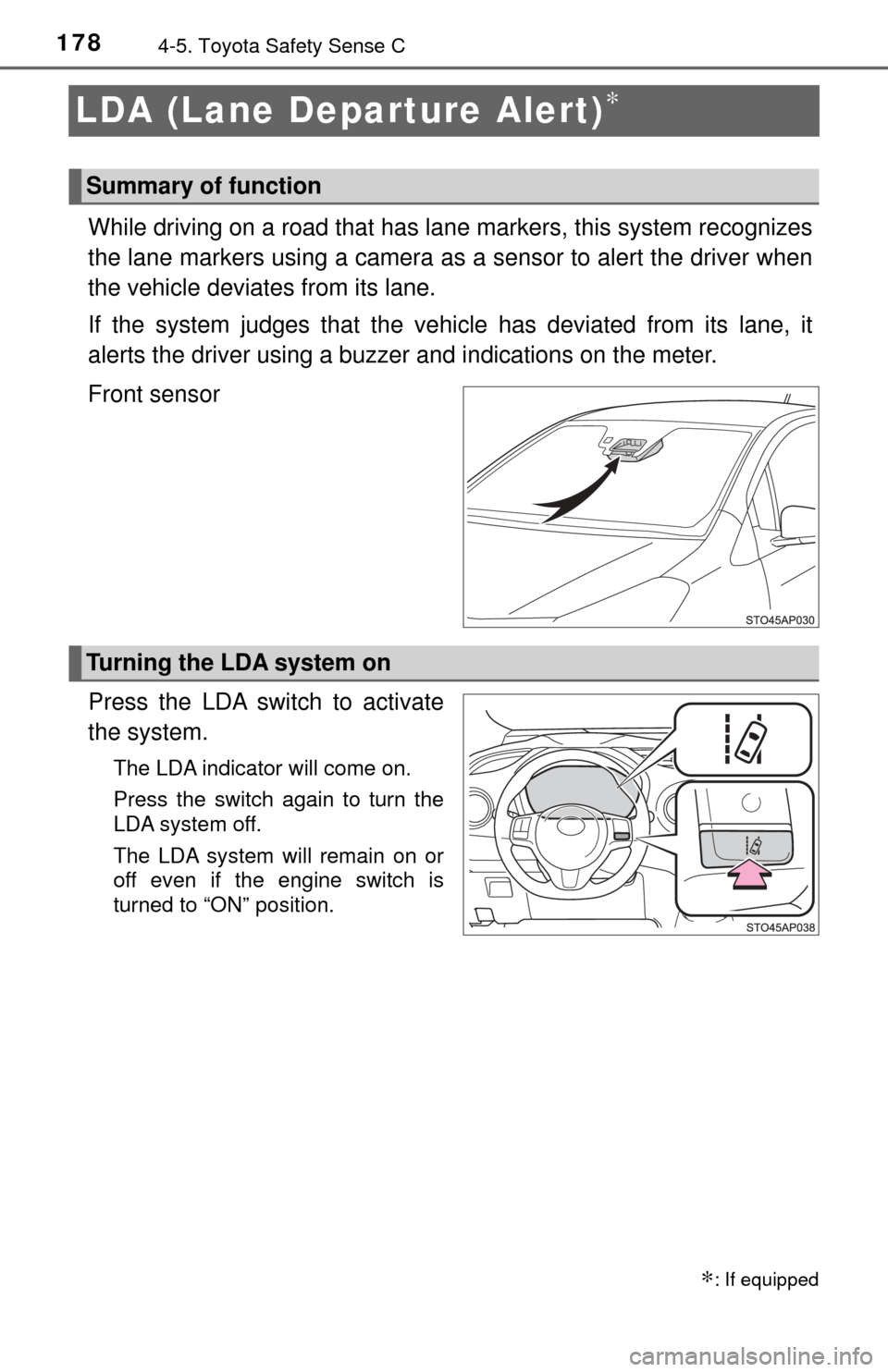
1784-5. Toyota Safety Sense C
LDA (Lane Departure Alert)∗
While driving on a road that has lane markers, this system recognizes
the lane markers using a camera as a sensor to alert the driver when
the vehicle deviat es from its lane.
If the system judges that the ve hicle has deviated from its lane, it
alerts the driver using a buzzer and indications on the meter.
Front sensor
Press the LDA switch to activate
the system.
The LDA indicator will come on.
Press the switch again to turn the
LDA system off.
The LDA system will remain on or
off even if the engine switch is
turned to “ON” position.
∗: If equipped
Summary of function
Turning the LDA system on
Page 179 of 396
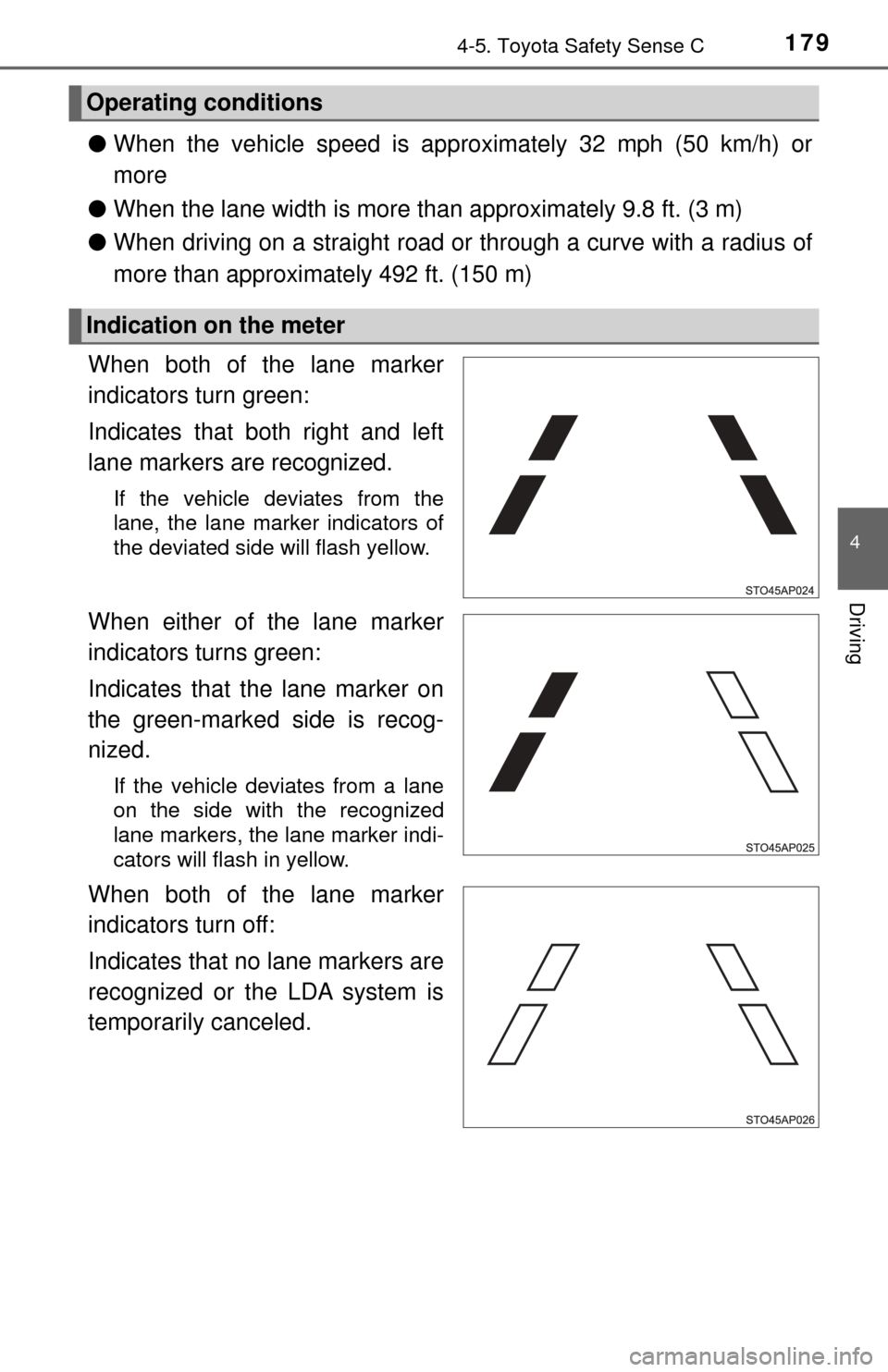
1794-5. Toyota Safety Sense C
4
Driving
●When the vehicle speed is approximately 32 mph (50 km/h) or
more
● When the lane width is more than approximately 9.8 ft. (3 m)
● When driving on a straight road or through a curve with a radius of
more than approximately 492 ft. (150 m)
When both of the lane marker
indicators turn green:
Indicates that both right and left
lane markers are recognized.
If the vehicle deviates from the
lane, the lane marker indicators of
the deviated side will flash yellow.
When either of the lane marker
indicators turns green:
Indicates that the lane marker on
the green-marked side is recog-
nized.
If the vehicle deviates from a lane
on the side with the recognized
lane markers, the lane marker indi-
cators will flash in yellow.
When both of the lane marker
indicators turn off:
Indicates that no lane markers are
recognized or the LDA system is
temporarily canceled.
Operating conditions
Indication on the meter
Page 180 of 396

1804-5. Toyota Safety Sense C
■Temporary cancelation of the LDA system functions
If any of the following occurs, the LDA system functions will be temporarily
canceled. The functions will resume after the necessary operating conditions
have returned.
●The turn signal lever is operated.
● The vehicle speed deviates from the operating range of the LDA system
functions.
● When the lane lines cannot be recognized while driving.
● When the lane departure warning sounds.
The lane departure warning function will not operate again for a several sec-
onds after it has been activated, even if the vehicle leaves the lane again.
■ The lane departure warning
Depending on the audio system sound level or air conditioning fan noise
while the audio system or air conditioning system is in use, it may be difficult
to hear the warning sound.
■ After the vehicle has been parked in the sun
The LDA system may not be immediately available. When the temperature in
the cabin decreases and the temperature around the front sensor ( →P. 161)
becomes suitable for its operation, the functions will begin to operate.
■ If there are lane markers on only one side of the vehicle
The lane departure warning will not operate for the side on which lane mark-
ers could not be recognized.
■ Conditions in which the function may not operate correctly
In the following situations, the front sensor may be unable to recognize lane
markers causing the lane departure warning function to operate incorrectly.
However, this does not indicate a malfunction.
●When driving through an area, such as a tollbooth, a crossing or before a
ticket checkpoint
● When driving on a sharp curve
● When lane markers are extremely narrow or extremely wide
● When the vehicle leans to one side an unusual amount due to a heavy load
or improper tire inflation pressure
● When the following distance between your vehicle and the vehicle ahead is
extremely short
● When the lane markers are yellow (These may be more difficult for the sys-
tem to recognize compared to white markers.)
● When the lane markers are broken, Botts’ dots (raised pavement markers)
or stones